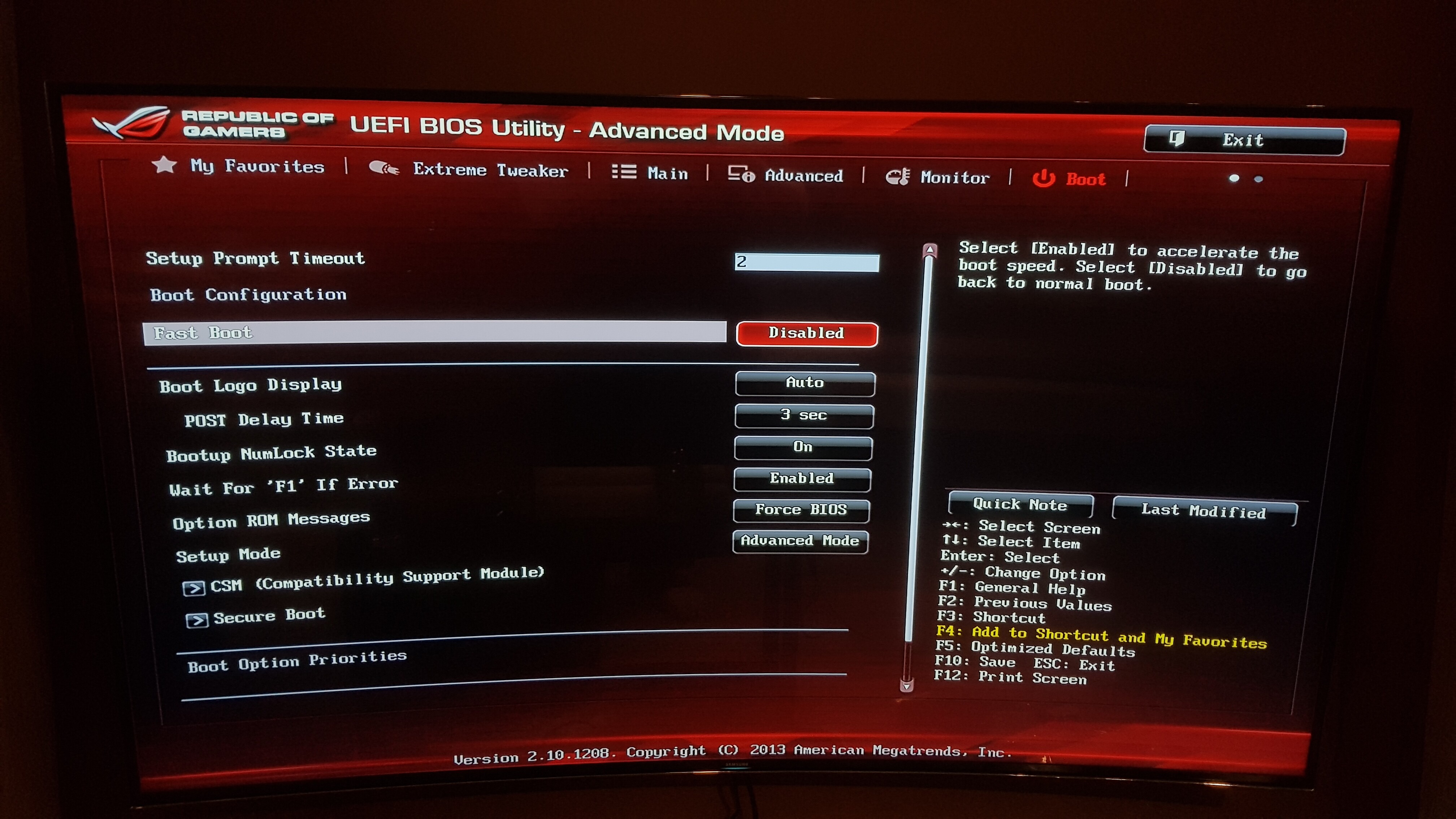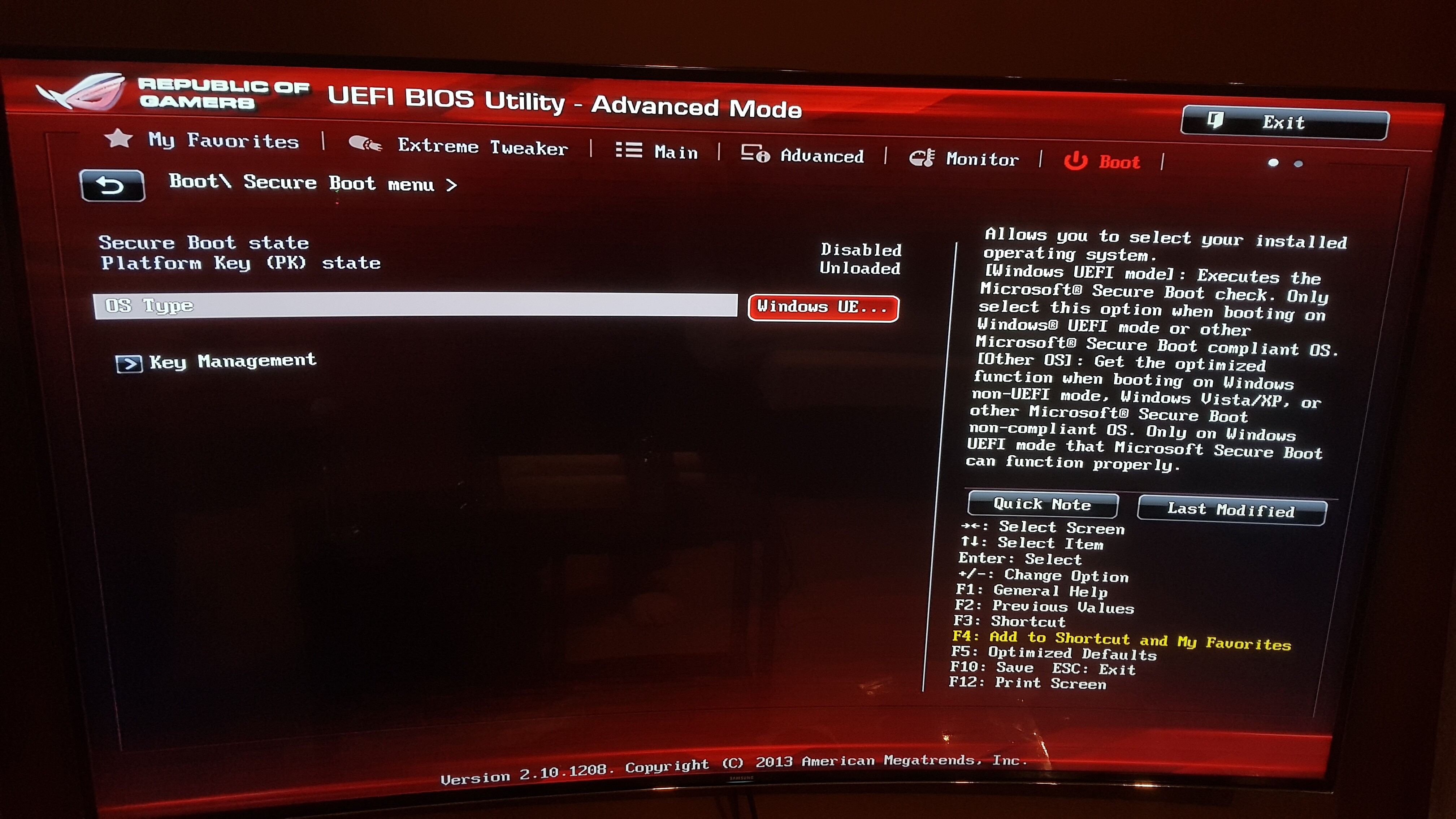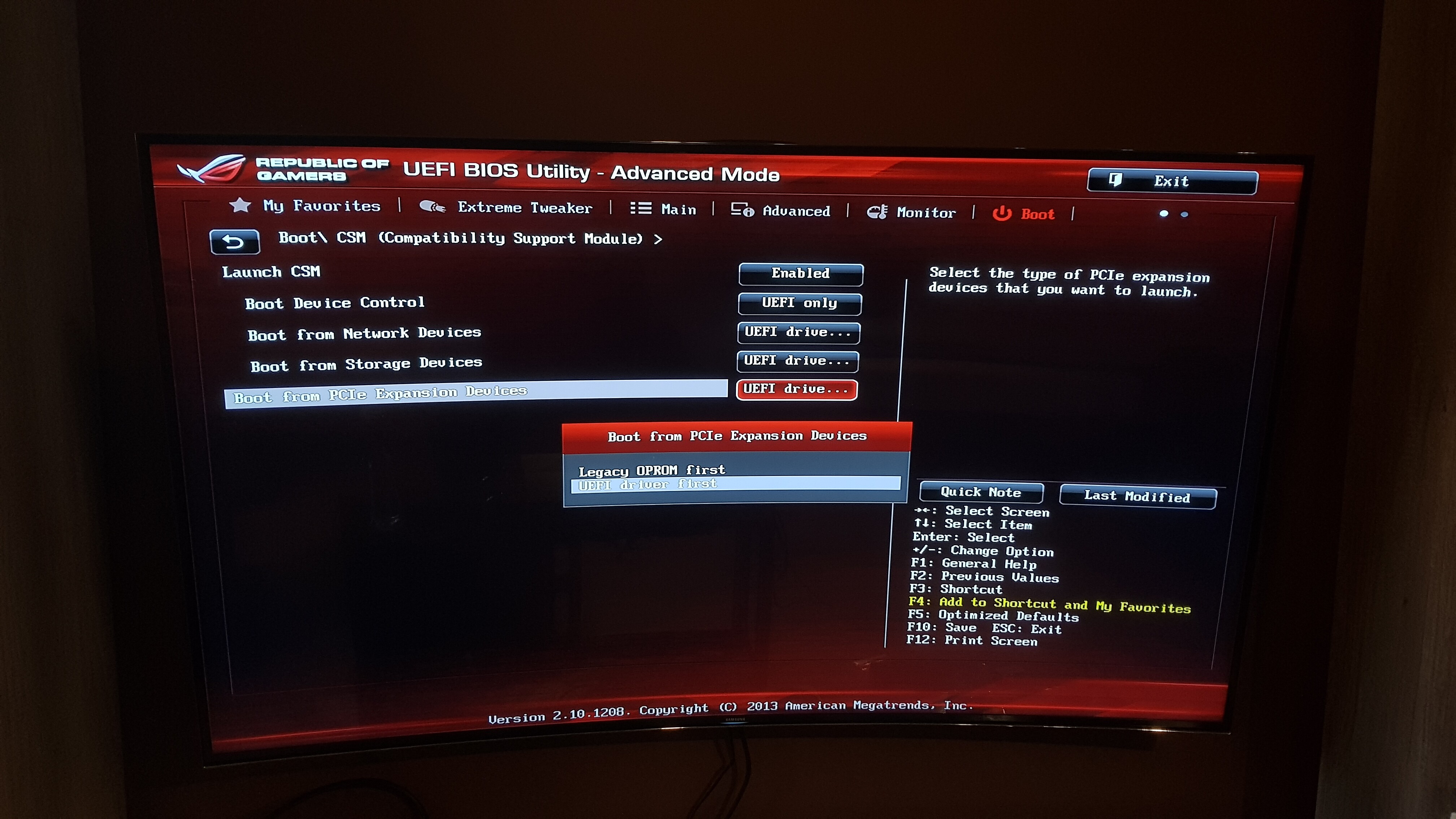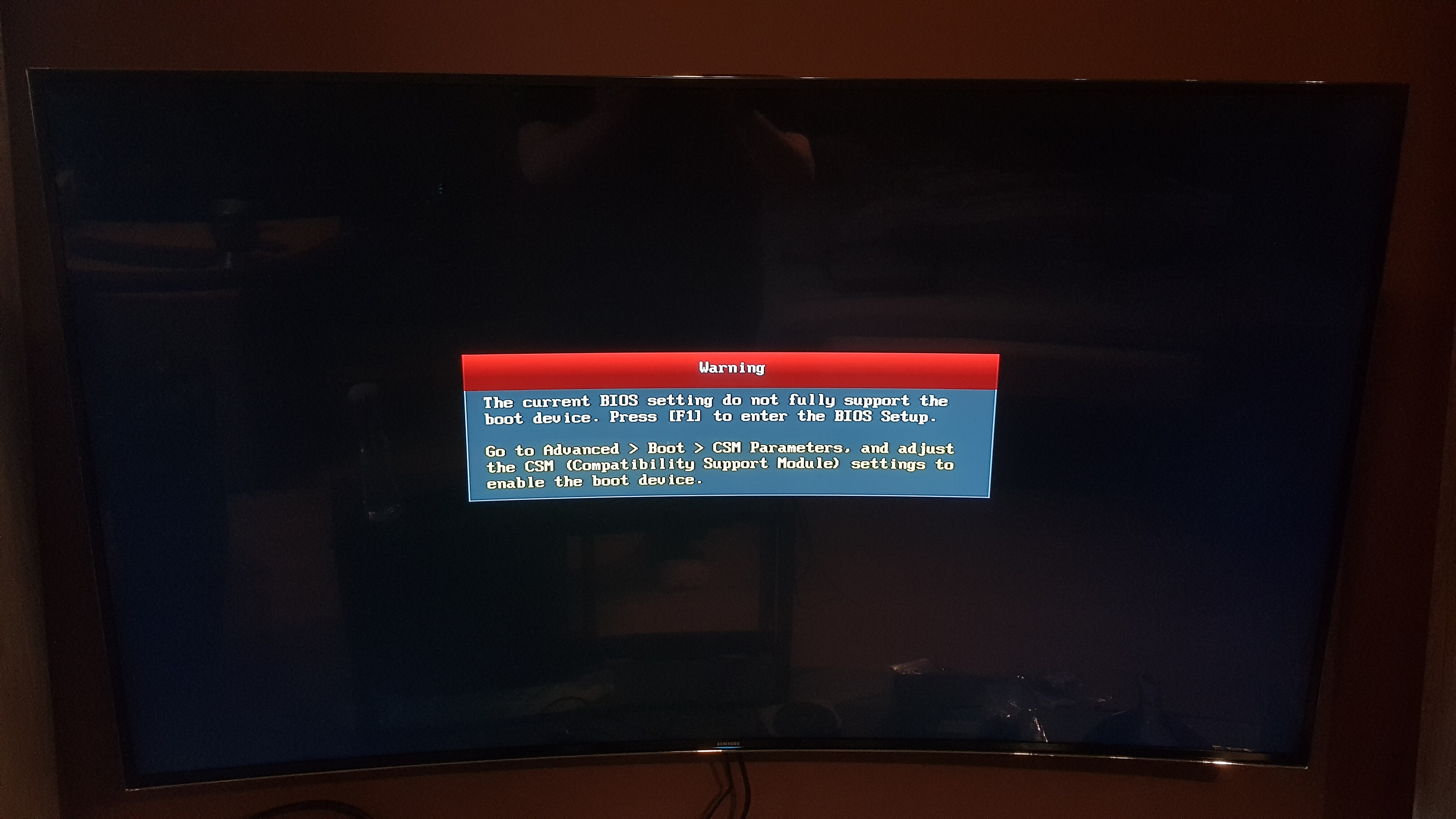- Fast Boot -> DISABLED
2. Secure Boot State -> DISABLED
3. Launch CMS -> ENABLED (like on 3rd screenshot)
At the end I get info that it can’t boot from that device. Any ideas what to do/what to try?








@N3buchadrezzar :
What exactly have you done until the point, where you get the message, that you cannot boot off that Disk Drive?
Which OS are you trying to install onto the NVMe SSD?
How did you try to get it installed?
@N3buchadrezzar :
Thanks for your quick reply.
No, it is not normal, that the USB Flashback procedure takes up to 2 hours. It should be finished within 2-3 minutes.
Provided, that you have booted the USB Flash Drive containing the Win10 x64 Pro Image in UEFI mode, I suspect, that the USB Flashback procedure failed and you still don’t have the required NVMe EFI module within your mainboard BIOS.
Are you sure, that you have flashed the modded BIOS correctly (using a small sized FAT32 formatted USB 2.0 stick)?
Yes, it’s 16GB USB 2.0 Pendrive formatted for FAT32. I’ve tried using USB 3.0 … results were the same.
Is there any other way to install modified BIOS?
It worked!! Success!!! I took 3rd USB drive and it flashed new bios in 2 minutes. Sorry for confusion ![]()
Oh… and thank you for your time. I’m pretty sure you have much better things to do in Saturday then read some post from a newbie like me xD
That’s fine!
I am glad, that I could help. By the way: It is Sunday here.
I finally got my 960 Pro installed (via a very nice kryoM.2 evo adapter). Can someone have a look at my benchmark scores? Stock Samsung SSD NVMe driver v2.2. Old 1B6Q firmware. Can’t do anymore benchmarking now since i have to leave for a few days. :’(
But i think that something is wrong … SMART won’t be read and Anvil doesn’t show any name…
—
Thanks everyone for making this possible!
They look fine. You can compare them with the scores I got with my 256 GB Samsung 960 EVO (look >here<).
Which name does Anvil’s Utilities not show?
See that white box down in the middle? Also none tool i used will show up any drive information or SMART values ![]()
Regarding benchmarks: seems that a 960 Evo would also have done the job ![]()
The white box is designed for the user’s input and the drive informations are on the right side of Anvil’s GUI.
Edit: Regarding the missing S.M.A.R.T. values: Anvil’s Storage Utilities is a benchmark tool and not a Question: Why do you expect from a benchmark tool and not a hardware diagnostic tool.
I don’t know any "pure" benchmark tool, which shows the S.M.A.R.T. values.
@powrslave :
Really, Window 7 and NVMe?
You can still upgrade from Windows 7 to Windows 10 for free here:
Link: https://www.microsoft.com/en-us/accessib…indows10upgrade
EDIT by Fernando: Unneeded fully quoted text (incl. images) replaced by direct addressing to the related author (to save space)
Hi,
i’ve the i7 3820 installed on the ASUS P9X79 Pro. I’ve seen that the new Samsung 960 series are very fast, and i decide to buy the ASUS Adapter Hyper M.2 x4 PCI and the SSD 960 EVO.
How can i config the mainboard to boot the OS ?
Now i can try to install the adpter and the SSD, boot into the Operating System, and format the SSD 960 EVO with GPT table and NTFS format. And then, boot the USB Windows 10 UEFI installation to install the Windows operaing system into the SSD 960 EVO. is it possible proceed how i’ve described before, or i must mod the BIOS ?
@mak387 :
Welcome at Win-RAID Forum!
Just follow my guide, which is within the start post of this thread.
I recommend to insert the required NVMe EFI module into the BIOS as written within the guide.
Good luck!
Dieter (alias Fernando)
Here is an updated version of the “NvmExpressDxe-64.efi / NvmExpressDxe-64.ffs” driver with the correct GUID as listed by edk2: NvmExpressDxe.inf
- Via Clover
– Extract the “Clover_*.pkg” with 7zip, WinRar, etc. and go into “NvmExpressDxe-64.pkg” and yeah… well… FckU Apple ^^
— Only way i found to extract the “Payload” file was via “Bash on Ubuntu on Windows” (who the heck came up with that name?^^): “gunzip -c Payload | cpio -i”
---- This will give us a file named “NvmExpressDxe-64.efi”
– Download edk2-BaseTools-win32: GenFfs.exe, GenSec.exe
– Now we are going to build our FFS file (NvmExpressDxe-64.ffs):
— GenSec -o pe32.sec NvmExpressDxe-64.efi -s EFI_SECTION_PE32
— GenSec -o ui.sec -s EFI_SECTION_USER_INTERFACE -n “NvmExpressDxe”
— GenSec -o version.sec -s EFI_SECTION_VERSION -n “1.0”
— GenFfs -g “5BE3BDF4-53CF-46a3-A6A9-73C34A6E5EE3” -o NvmExpressDxe-64.ffs -i pe32.sec -i ui.sec -i version.sec -t EFI_FV_FILETYPE_DRIVER
– Done ![]()
- Build from source (Linux/Windows)
– Instructions for Linux:
— Using EDK II with Native GCC
— Common instructions for Linux
— Additional: EDK2 @ Ubuntu Wiki
– Instructions for Windows:
— Windows systems
– Proceed as mentioned above
—
I hope that everything is correct. Can’t test the module now but it should work. Maybe someone wants to be the guinea pig? ;>
NvmExpressDxe-64.rar (14.7 KB)
My Z87 - Pro does not have PCI 3.0 X4 slot
I am running one gtx970 card
My understanding is this is pointless on this mb yes?
Wow… so much to go through.
I tried this little experiment last October without much success. I came down to having needing to remove some files to get the size under the max allotted. At the time I didn’t know what file I could lose so I picked on. Long story short, it didn’t work. I have seen that there has been some new activity with these posts and more successes.
So a simply question, I have an Asus G751JT Laptop. It takes an AHCI M.2 just fine, but I have an extra NVMe one I would like to use. Has anyone does a BIOS mod for this particular laptop? Asus at one time offered folks the chance to send my laptop in and get a new motherboard that accepts SLI but I missed out on that. Turns out that MB update also fixed the NVMe issue so I’m doubly pissed.
Anyway if anyone has successfully modded a BIOS for this motherboard, I would be grateful if you could upload it for me. I still have all the tools from the last attempt, but I’m a little skittish as it didn’t work before.
Thanks,
BT
i’ve windows system, but i’ve not understand how can i modify the bios.
This procedure is safe, or i could broke the mainboard ?
@e.v.o :
Thanks for having found a new/updated NvmExpressDxE.ffs module and thanks for having customized and attached it for users, who are willing to test it.
As soon as I get a positive feedback, I will present the updated NVMe module as *.ffs and *.efi file within the start post of this thread.
Question: Do you know the date of the body’s code compilation by the Clover/EDK2 Team?
@powrslave :
Although your mainboard doesn’t offer 4 PCI 3.0 lanes for your NVMe SSD, you will benefit from the performance boost.
@Brighttail :
Welcome at Win-RAID Forum!
Please attach the not working modded BIOS as *.zip or *.rar archive and I will do a look into it.
Regards
Dieter (alias Fernando)
@mak387 :
The BIOS modding procedure itself is safe, the only risky part is the flashing of a not correctly modded BIOS. Nevertheless I don’t know any user, who has bricked his mainboard by flashing a BIOS, where just an originally not present EFI module had been inserted.
If you are unsure regarding your BIOS modding result, you can attach the modded BIOS as *.zip or *.rar archve and we will do a look into it.
It’s from version 2.4, revision 4061 from 2017-04-19: Clover_v2.4k_r4061.zip.
Clover Changelogs can be found here: Clover Change Explanations
But i don’t know which EDK2 revision they used. The latest revision of the NVMe driver from EDK2 on GitHub was updated 3 days ago: NvmExpressDxe. Before this the latest change was made 3 Months ago. So if the Clover team uses the latest and greatest for compilation i would guess the revision from 3 months ago was used.
—
It’s not pointless. I also have a Z87 ASUS mainboard. As the screenshot cleary states you have 2 PCIe 3.0 x16 and 1 PCIe 2.0 x16. You have to use the second PCIe 3.0 x16 slot (look it up on the mainboard or in the manual) and everything will be fine. Just don’t use the PCIe 2.0 x16 port as this one isn’t directly connected to the CPU and won’t get you the best performance. You won’t see any performance impact regarding your GTX running only on x8 afterwards if that was your question ![]()